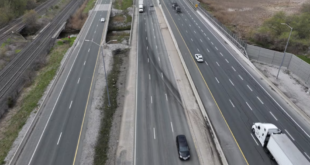Officers recount pepper-spraying people’s faces, using bike frames to push protesters.

Lisa Lachance wasn’t expecting to spend the day after the 2021 Nova Scotia election standing face-to-face with police officers in riot gear.
Lachance, the member of the provincial legislature who represents Halifax Citadel-Sable Island, heard about a large protest in the riding to stop police and city workers from removing tents and shelters in parks used by people who were homeless and thought they’d better attend.
“We basically stood facing one of the lines of police,” Lachance said in a recent interview.
“What we were trying to do was just have a conversation and just say we need to de-escalate because as we were standing there more and more people were coming,” they said.
“It was a highly volatile situation.”
Now, CBC News has obtained internal police documents revealing new information about the day police and protesters clashed, including officer accounts of what they did and why.

The documents suggest Halifax Regional Police (HRP) examined officers’ actions and concluded almost everything the department did that day was correct.
That’s a view not shared by critics of the police actions such as Lachance, who filed a formal complaint about the handling of the protest.
‘Overall objectives were completed’
On Aug. 18, 2021, hundreds of people gathered on Spring Garden Road in downtown Halifax to block the removal of tents and wooden shelters used by people who were homeless.
Police and city workers were enforcing a municipal bylaw against living in parks. Police used pepper spray, and paramedics treated at least 21 people at the scene.
An external review is underway of the police use of force, aiming to answer questions about how the operation was done for the public and the civilian board overseeing police.
- Halifax police board to review how shelter evictions, protest were handled
- Mayor defends homeless evictions, but housing advocates call them ‘unconscionable’
In documents obtained by CBC under access to information, HRP deemed its “overall objectives were completed” and said no officers did anything wrong.
CBC requested an interview with HRP to discuss the events of the protest.
HRP declined, citing the ongoing external review.

What CBC News learned analyzing video, police reports detailing clash with protesters over Halifax homeless shelters
On Aug. 18, 2021, downtown Halifax erupted in a sprawling protest against the removal of homeless shelters from a park. Two years later, police reports from that day were released to CBC News.
The timeline
Police and city workers removed tents at three city parks before 8 a.m. that day. After that, incident commander Supt. Andrew Matthews wrote the decision was made to move to the small park around the former library building on Spring Garden Road.
However, there were two wooden structures beside the old library being lived in by people who were homeless. The documents describe how “non-police staff” waited for equipment to disassemble the structures and deliver them to a facility in Dartmouth’s Burnside Business Park for safekeeping.
- Get the news you need without restrictions. Download our free CBC News App.
“Operationally, delays aggravated the situation and afforded protesters to mobilize,” Matthews’s “after-action” report said.
That report, and use of force reports, describe how a man from the protest group climbed on top of one of the wood structures and refused to leave. Other protesters blocked the way with their bodies. The standoff lasted for hours as the crowd grew.

A police negotiator, Const. Trevor Lassaline, was brought in to try to talk down the protester on the shelter roof.
Around 3 p.m., the man agreed to get off the roof and be arrested. As the man was put in handcuffs and escorted to a waiting police van on Brunswick Street, some in the crowd tried to stop the arrest.
Some protesters blocked the path of the van with their bodies. On the Brunswick Street side of the library site, police tried to push protestors back. In use of force reports, some officers described being “overwhelmed” or “surrounded.”
“There were pockets of protesters everywhere lashing with great intensity and blind rage against officers,” one officer wrote.
Between approximately 3 p.m. and 3:30 p.m., at least one officer sent an emergency radio code an officer was down.
The scene was chaotic; officers who were in other areas of the library site ran toward Brunswick Street.

People in the crowd threw water bottles at the police. A dispatcher went on the police radio and reported a possible gun sighting in the crowd. An officer in a police car drove into an officer on the roadway at Brunswick and Doyle streets.
Multiple officers started using pepper spray on individuals or in a wide arc. Four officers wrote in their use of force reports they were affected by the spray, in some cases catching it in the face or eyes.
11 reports of pepper spray
CBC obtained 29 examples of use of force reports filed by HRP officers following the protest.
Of those, 11 officers filed reports saying they used pepper spray on people. Two others said they didn’t deploy pepper spray, but displayed it to make the crowd back off.
Two types of dispersal methods were used: a fogger that produces a wide angle spray and a “pepperball launcher” that can shoot a targeted capsule at a distance.

Some officers wrote about using pepper spray against specific people in the crowd, targeting faces directly.
Other officers used pepper spray more widely, resulting in some officers getting hit in the face and “cross-contaminated.”
“I believe I sprayed at least 30 people,” one officer wrote. “I sprayed the fogger into the crowd of people as a last resort to gain compliance and to prevent further officers from being injured.”
Bicycles as barriers
The documents released to CBC show HRP’s Bicycle Rapid Response Team was an integral part of the crowd-control response.
Three officers, including one who identified themselves as the team leader, wrote about using the “chest push” or “bike pushback” technique on the crowd, as they had been trained to do.

The officers wrote they warned protesters in advance, sometimes struck protesters with bikes as they pushed them back and that protesters tried to punch, kick or grab the bikes.
“All force applied with my bike was under direction of my team lead … which stems from the chain of command,” one wrote.
12 officers had ‘minor injuries’
In the after-action document, HRP noted 12 officers had “minor injuries” following the event.
Most injuries didn’t require professional medical attention, including a rolled ankle, scrapes and bruises, a bite on the right hand and soreness caused by falling to the ground.
One officer said they had been pushing protesters back for a long time and later realized their ribs were sore and breathing was painful. A chiropractor said a rib popped out of place.
Another officer reported going to hospital for a suspected concussion after being “struck with an apple.”
Another filed a Workers Compensation Board report that included being “pepper-sprayed by protesters,” and some records stated the officer who was pepper-sprayed in the face had to go to hospital.
Protesters using skateboards, plums and head-butts: police
One officer described being sprayed in the face by a protester with “what is believed to be bear spray.” That officer did a “hard controlled takedown,” putting the person on the ground.
Several officers described the crowd throwing water bottles. In one case, an officer listed weapons carried by protesters as a “skateboard, water bottles (full), various types of food.”
“I observed several full 500-millilitre water bottles thrown at high velocity at police officers,” the officer wrote.
“I also observed apples, plums, oranges and other assorted foods being thrown.”
The same officer wrote about seeing people carrying two-litre jugs of milk, believed to be meant for decontamination after pepper spray.

One officer described seeing “large crowds kicking and punching police vehicles, pushing officers, swinging skateboards.”
Another officer wrote that someone “gripped my police vest and radio cord and began to pull me into the crowd.”
Complaint filed seeking officer accountability
Approximately a month after the protest, Lachance filed an official complaint with HRP, asking for an investigation of the department’s actions.
Lachance believed there hadn’t been enough done to de-escalate the situation and were concerned about a lack of officers’ name tags, which they called “pervasive.” They estimated they were not able to see name tags on approximately half the officers they saw.
The internal investigation took until April 2022, when Chief Dan Kinsella concluded all Lachance’s concerns were “unfounded,” although there was video evidence some officers were not wearing name tags.
He didn’t say how many officers lacked name tags, but added the officers acknowledged the missing tags to investigators and “provided explanations.”
Those explanations included one officer who believed a protester ripped it off and officers who responded to the call quickly and didn’t have time to check their uniforms.

In Kinsella’s decision, he also wrote about a report of an officer with a “thin blue line” patch on their uniform. The patch has become a divisive symbol some see as a tribute to fallen officers and others see as a symbol with ties to white nationalism. Kinsella said the department sent out an email to all members on Aug. 24, 2021, reminding them to only wear insignia authorized by the chief.
De-escalation attempts
Kinsella also addressed the allegation police did not attempt to de-escalate the situation.
He reviewed video taken by an officer assigned to capture the day and noted officers told the crowd to “move back” or “move back please” more than 40 times in the first four minutes of the video.
“Protesters ignored these commands and pushed forward. It appeared the crowd had an agenda they were determined to follow through,” he wrote in his decision.

Kinsella wrote HRP was “acting lawfully” in its enforcement of the municipal bylaw.
Lachance said they were disappointed by the police response to their complaint.
“How do we do this next time?” Lachance said.
“People protest. That’s a right we have in Canada and I want that to be done safely. We need to be able to do that in our society and I didn’t see a path forward.”
The final report from the external review of the police response by Toronto law firm Cooper, Sandler, Shime and Schwartzentruber will be delivered to the public by next June.
ABOUT THE AUTHOR
Shaina Luck is an investigative reporter with CBC Nova Scotia. She has worked with local and network programs including The National and The Fifth Estate. Email: shaina.luck@cbc.ca
*****
Credit belongs to : www.cbc.ca
 Atin Ito First Filipino Community Newspaper in Ontario
Atin Ito First Filipino Community Newspaper in Ontario






